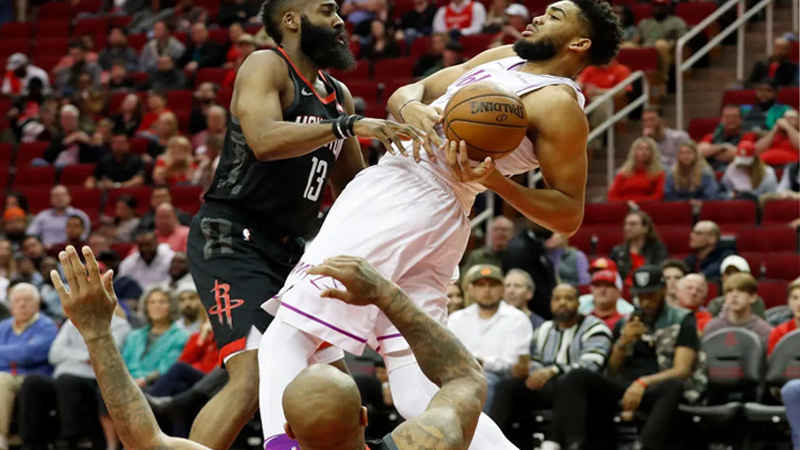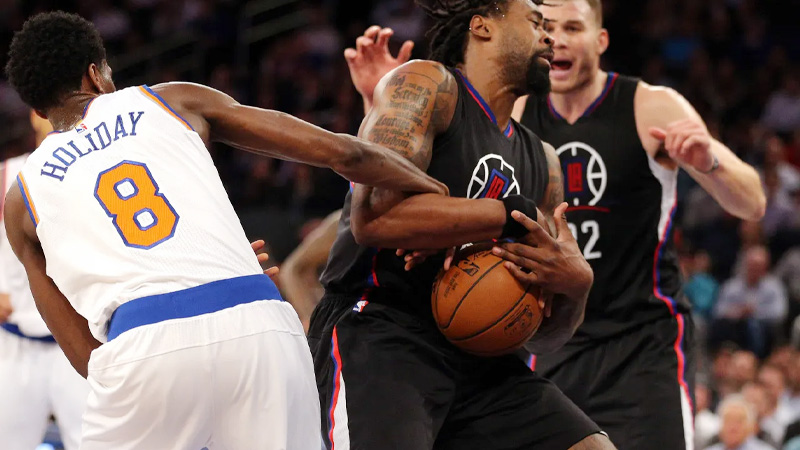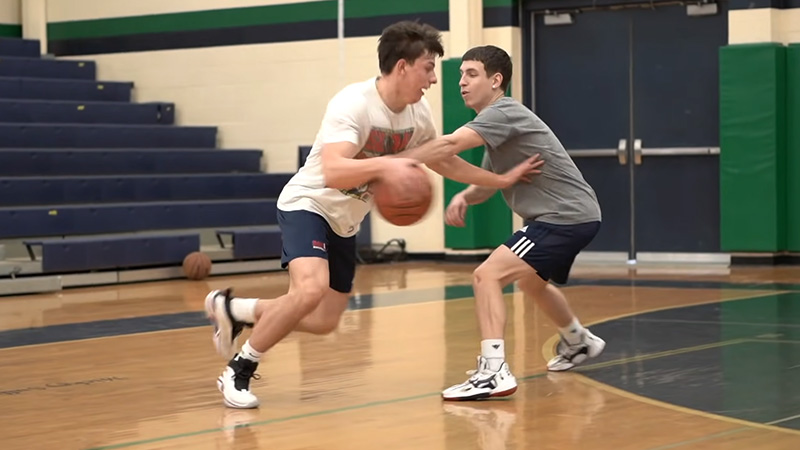Basketball is a dynamic and fast-paced sport that demands both skillful offense and tenacious defense. While the offense is all about scoring points and making impressive plays, defense plays an equally critical role in thwarting the opposition’s efforts.
However, defense is a fine line to walk, and sometimes, players can cross that line and commit fouls in their attempt to disrupt the flow of the game. One such commonly encountered foul in basketball is the “Reach-in Foul.”
In this blog post, we will delve into the intricacies of what constitutes a reach-in foul, its impact on the game, and how it influences player strategies and team dynamics. So, stay focused.
What is Reach-in Foul in Basketball?
In basketball, a “reach-in foul” is a type of personal foul committed by a defensive player. It occurs when the defensive player reaches in and makes contact with an offensive player who is in possession of the ball.
Reach-in fouls are typically called when the defensive player swipes or reaches across the body of the offensive player in an attempt to steal or disrupt the ball-handling.
The main characteristics of a reach-in foul are:
Contact with the Ball-Handler
The defensive player makes physical contact with the offensive player who is holding or dribbling the basketball.
Illegal Use of Hands or Arms
The defensive player uses their hands, arms, or body in a way that is not considered legal defense, often trying to reach for the ball or disrupt the offensive player’s movements.
No Positional Advantage
The defensive player does not have a proper defensive stance or is not in a position to make a legitimate play on the ball without making contact with the offensive player.
Reach-in fouls are a common type of foul and are often called during intense defensive efforts or when players are attempting to create turnovers.
When a reach-in foul is committed, the offensive team is awarded free throws, depending on the number of team fouls accumulated during a specific period.
Repeated reach-in fouls by a player can lead to foul trouble for that player and may result in them having to sit on the bench to avoid fouling out of the game.
Reach-in Foul in Basketball in NBA

Source: thestadiumsguide
In the NBA, a “reach-in foul” refers to the same concept as in general basketball terms. It is a personal foul committed by a defensive player when they make contact with an offensive player who is in possession of the ball.
This type of foul is called when the defender reaches in and makes illegal physical contact while attempting to steal the ball or disrupt the offensive player’s movements.
The NBA, like other basketball leagues, has rules and regulations to prevent overly aggressive or illegal defensive tactics. When a reach-in foul is committed, the fouled player is awarded free throws if their team is in the bonus.
The NBA’s rules on fouls and their enforcement are consistent with the standard basketball rules, but there may be slight differences in how officials interpret and call certain situations due to the speed and intensity of the game at the professional level.
NBA referees are tasked with making quick and accurate judgments during gameplay to ensure fair competition and player safety.
Penalties for Reach-in Foul in Basketball
The penalties for a reach-in foul in basketball, including the NBA, can vary based on the specific game situation and the number of team fouls accumulated. Here are the common penalties for reach-in fouls:
Personal Foul
When a player commits a reach-in foul, it is considered a personal foul. Personal fouls are accumulated by individual players, and they are recorded in the official scorekeeping.
Free Throws
If the fouled team is in the bonus (usually after the opposing team has committed a certain number of team fouls in a specific period), the fouled player is awarded free throws.
The exact number of free throws depends on the league rules and the specific foul situation. In the NBA, the bonus is typically reached on the fifth team foul in a quarter.
- If the player attempting the shot was in the act of shooting when fouled, they are awarded the number of free throws corresponding to the type of shot they were attempting (e.g., two free throws for a missed two-point shot, three free throws for a missed three-point shot).
- If the player was not in the act of shooting when fouled, the fouled team is still awarded free throws. In the NBA, on the fourth team foul in a quarter, the opposing team is awarded two free throws, and on the fifth and subsequent team fouls.
Team Foul Count Reset
In some leagues, the team foul count is reset at the beginning of each quarter or half, while in others, it carries over from one period to another. The number of team fouls determines when the fouled team enters the bonus and starts shooting free throws.
Foul Trouble for Players
Individual players committing reach-in fouls may accumulate personal fouls throughout the game.
If a player accumulates a certain number of personal fouls, they will be disqualified from the game, a situation known as “fouling out.” When a player fouls out, they must leave the game, and their team plays with one fewer player for the remainder of the game.
It’s important to note that the specific rules and penalties for reach-in fouls can vary between different basketball leagues and organizations.
When Do Reach-in Fouls Occure?

Source: marciatravessoni
Reach-in fouls occur in basketball when a defensive player makes illegal physical contact with an offensive player who is in possession of the ball.
These fouls typically happen when the defender tries to steal the ball or disrupt the offensive player’s dribble or movement by reaching across the body or swiping at the ball. Here are some common situations in which reach-in fouls may occur:
Stealing the Ball
The defensive player tries to reach in and take the ball away from the offensive player’s hands while they are dribbling or holding it. If the defender makes contact with the offensive player’s hand or arm instead of cleanly getting the ball, it can be called a reach-in foul.
Reaching Across the Body
Instead of moving their feet and maintaining a proper defensive position, a defender may reach across the body of the offensive player to try to knock the ball loose. This type of reach is often penalized as a foul if it involves illegal contact.
Overcommitting on Defense
When a defender overcommits and tries to steal the ball from an offensive player who is driving to the basket or attempting a shot, they may inadvertently make illegal contact, leading to a reach-in foul.
Double Teaming
In situations where two defenders are attempting to trap an offensive player, one of the defenders might reach in and commit a foul if they make contact with the ball-handler or their arms during the trap.
Reaching during Passing
A defender may commit a reach-in foul when trying to intercept or disrupt a pass from the offensive player to a teammate. If the defender makes contact with the offensive player instead of cleanly intercepting the pass, a foul may be called.
It’s essential for defenders to play with discipline and avoid committing reach-in fouls.
Free Throws in Reach-in Foul
In basketball, when a reach-in foul is committed, the fouled player’s team is often awarded free throws as a penalty against the defensive team.
The number of free throws awarded and the specific circumstances can vary based on the league, level of play, and the number of team fouls accumulated.
Here’s how free throws are typically awarded for reach-in fouls:
Shooting Fouls
If the player who was fouled was in the act of shooting when the reach-in foul occurred, they will be awarded free throws. The number of free throws depends on whether the shot attempt was from a two-point area or beyond the three-point line.
- If the fouled player was attempting a two-point shot and was fouled, they will be awarded two free throws.
- If the fouled player was attempting a three-point shot and was fouled, they will be awarded three free throws.
Non-Shooting Fouls
If the player who was fouled was not in the act of shooting when the reach-in foul occurred (e.g., during dribbling or passing), the team is still awarded free throws as a penalty for the foul. However, the number of free throws and the specific team foul situation come into play.
- In the NBA, on the fourth team foul in a quarter, the opposing team is awarded two free throws. On the fifth and subsequent team fouls in the same quarter, the opposing team is awarded two free throws.
- If the non-shooting foul occurs when the team is already in the bonus (after the fifth team foul), the fouled player will be awarded two free throws.
- In some leagues, team fouls reset at the beginning of each quarter or half, while in others, they carry over from one period to another.
It’s important to note that basketball rules can differ slightly between different leagues and organizations.
Significance of Reach-in Foul in Basketball
The reach-in foul is a significant aspect of basketball, and its significance lies in several key areas:
Personal Fouls and Team Fouls
A reach-in foul is considered a personal foul, and it is recorded against the individual player committing the foul. Accumulating personal fouls can have implications for both the player committing the fouls and their team.
In many leagues, players are limited to a certain number of personal fouls (e.g., five in the NBA) before they are disqualified from the game (fouling out). This can lead to strategic decisions by coaches and impact the team’s defense and overall gameplay.
Free Throws and Scoring Opportunities
Reach-in fouls often result in free throws for the fouled team. This creates scoring opportunities without the clock running, allowing teams to potentially score points even when the clock is stopped.
Successfully converting free throws can swing the momentum of a game, especially in close contests.
Foul Trouble and Player Management
Reach-in fouls can put players in foul trouble, forcing them to be cautious on defense to avoid fouling out of the game. When a key defensive player gets into foul trouble, it can affect the team’s ability to effectively defend the opposition.
Coaches must manage their players’ minutes strategically to avoid losing key contributors due to fouling out.
Strategic Impact
The presence of the reach-in foul rule forces teams to be mindful of their defensive approach. Too many reach-in fouls can lead to opponents earning numerous free throw opportunities, potentially allowing them to build a lead or catch up.
Coaches and players must strike a balance between aggressive defense and avoiding excessive fouling.
Game Flow and Momentum
Reach-in fouls can disrupt the flow of the game, leading to more stoppages and interruptions in play. Frequent fouls can alter the momentum, momentum, and rhythm of both teams, making it challenging for either side to find their groove.
Defensive Techniques and Discipline
The concept of the reach-in foul reinforces the importance of disciplined defensive techniques. Players are encouraged to use legal and well-timed moves to challenge offensive plays, rather than resorting to risky reach-ins that may result in fouls.
Player Development
The concept of reach-in fouls is crucial for player development, especially at a young age. As players progress in their basketball skills, they learn to defend effectively without resorting to illegal physical contact, thus becoming more well-rounded and disciplined athletes.
FAQs
What is a reach-in foul in basketball?
A reach-in foul in basketball occurs when a defensive player makes illegal physical contact with an offensive player who is in possession of the ball.
The foul is called when the defender reaches across the body of the offensive player in an attempt to steal the ball or disrupt their movement.
How is a reach-in foul penalized?
The penalty for a reach-in foul usually involves awarding free throws to the fouled player’s team. If the foul occurs during a shooting attempt, the fouled player is awarded two or three free throws, depending on whether it was a two-point or three-point attempt.
If the foul is non-shooting or the team is already in the bonus, the fouled player is awarded two free throws.
How does a reach-in foul impact a player’s game?
For players committing reach-in fouls, the foul count is recorded against them individually.
Accumulating a certain number of personal fouls (typically five in the NBA) leads to fouling out of the game, forcing the player to sit out for the remainder of the match. This can significantly impact a team’s defensive strategy and rotations.
How do reach-in fouls influence game flow and momentum?
Reach-in fouls can disrupt the flow of the game and create stoppages, impacting the natural rhythm of play. Frequent fouls can lead to a more disjointed game, affecting both offensive and defensive strategies.
Additionally, successful free throws resulting from reach-in fouls can swing the momentum in favor of the fouled team.
What are the strategies to avoid reach-in fouls?
To avoid reach-in fouls, defenders must focus on proper defensive positioning and footwork. Instead of reaching in, players should aim to anticipate the offensive player’s moves and use legal methods to challenge shots or passes.
Staying disciplined on defense and avoiding unnecessary risks is key to preventing reach-in fouls.
Conclusion
The reach-in foul is a crucial aspect of basketball, serving as a reminder of the delicate balance between aggressive defense and maintaining sportsmanship on the court.
The rules and implications of reach-in fouls help players develop disciplined defensive techniques and enhance the overall integrity of the game.
With coaches emphasizing proper defensive positioning and players exercising restraint, basketball can continue to be a thrilling display of skill and strategy without compromising on fair play.
So, next time you’re watching a game, keep an eye out for those reach-in fouls and appreciate the complexities they bring to this beloved sport. Best of luck.







